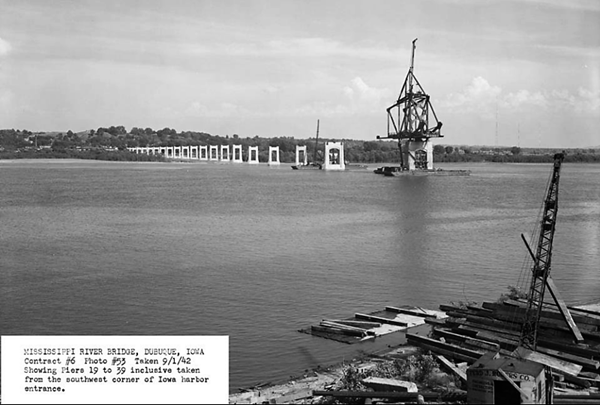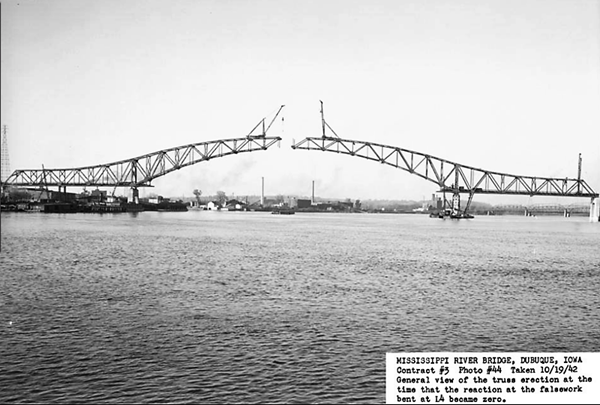On August 31, 1943, the Julien Dubuque Bridge opened to traffic crossing the Mississippi River between Dubuque, Iowa, and East Dubuque, Illinois. At that time, the 5,635-foot-long bridge’s 842-foot cantilever span was the second longest span crossing the Mississippi River, the fourth longest in the United States, and the eighth longest in the world.

By 1938 it had become obvious that Dubuque needed a new bridge across the Mississippi River. The 1887 Dubuque High Bridge or Wagon Bridge that carried Highway 20 across the river from Illinois to 4th Street near the Dubuque Star Brewery was more than 50 years old and in need of replacement. Iowa Governor Nelson Kraschel ordered a new route for Highway 20 to help alleviate traffic problems in downtown Dubuque caused by the highway winding through the community on six different streets. The U.S. Congress authorized the creation of a City of Dubuque Bridge Commission on April 26, 1938.
Problems plagued the plans for the new bridge from the beginning. Owners of private toll bridges across the Mississippi voiced opposition over tax exempt bonds to fund the bridge. Their concerns were heard. In 1939, President Roosevelt signed legislation authorizing taxable bonds to fund the bridge.
Contention over the location of the bridge created even more dissention. The U.S. Army Corps of Engineers and barge lines expressed concern over possible river navigation problems. The Dubuque Dock Commission objected to the Dodge Street location as they had plans to build a grain elevator in the area. The Greater Dubuque Association maintained the Dodge Street location would adversely impact dock terminals and city traffic. Local businessmen wanted Highway 20 to continue to run through Dubuque’s downtown.
Officials responded and said the adverse impact on river navigation could be eliminated by increasing the main span of the bridge to 845 feet instead of the original 350 feet – a change that would add $400,000 to the cost of the bridge. The U.S. Bureau of Roads had pledged $700,000 toward construction, but those funds would only be available if the Dodge Street location was chosen. And so it was.
Construction on the Julien Dubuque Bridge, a continuous steel-arch truss bridge with a suspended deck, got underway in April 1941 on both the eastern Illinois and western Iowa shores of the Mississippi. Bethlehem Steel received the contract for the bridge construction. The original bid of $1,714,118 was reduced to $1,588,618 to meet the bonding capacity of the Bridge Commission which was only able to sell $2,800,000 in bonds while the bridge and approaches were expected to cost more than $3 million.

Bridge statistics are impressive. It measured 6,400 feet in length and rose 842 feet over the river at its highest point. Construction used 7,000 tons of structure steel, 1,000 tons of reinforcing steel, 2.5 million linear feet of piling, and 30,000 cubic yards of concrete. Because WWII continued to rage overseas, the bridge was painted grey to provide camouflage in case of an air attack. The total cost of the bridge amounted to $3.1 million.
When the bridge opened on August 31, 1943, free passage was granted for the first fifteen hours. “War conditions” permitted “only simple ceremonies,” according to a Telegraph Herald story. The first tolls were collected the next day beginning at 4:00 a.m. Tolls generated by increased traffic allowed tolls to be discontinued on December 27, 1954, fourteen years earlier than had been anticipated. On August 16, 1955, the Bridge Commission was dissolved.
The old Dubuque High Bridge or Wagon Bridge located south of the railroad bridge became obsolete. It was sold for less than $500,000 and then torn down in 1944.
In 1975, ahead of the U.S. 1976 Bicentennial, Dubuque’s City Council considered painting the bridge red, white, and blue. East Dubuque’s City Council opposed the idea and reached out to the Iowa Department of Transportation Commission. Dubuque abandoned the plan.
During nine months beginning in February 1991, the Julien Dubuque Bridge was closed to facilitate a $13.4 million reconstruction. A new deck was built and both Iowa and Illinois bridge approaches were rebuilt. On November 2, 1991, a ceremony and procession of antique cars and pedestrians celebrated the reopening of the bridge.
Concerns over congestion on the Julien Dubuque Bridge began to be voiced as early as 1997 when the suggestion of a tandem, two-lane bridge was discussed. Plans did not move forward. In 2002, more discussion centered around adding another bridge that either replicated the Julien Dubuque Bridge or the newer design of the Iowa-Wisconsin Bridge. Plans did not move beyond the discussion phase.
The Julien Dubuque Bridge was named one of the top ten bridges in the country by Road and Bridges Magazine in 2003. In 2022, the bridge was listed on the National Register of Historic Places. Unfortunately, the bridge also found its way onto the Iowa Department of Transportation’s (IDOT) list of top ten major bridges that would need to be replaced within the next 20 years. The most recent estimated cost for a new bridge came in at $330 million. An October 2021 inspection found the Julien Dubuque Bridge to be in good condition with only minor problems and deterioration. Officials agree that while the bridge is still in satisfactory condition, at some point it will make more sense to replace it than build a tandem bridge next to it.


Comment here